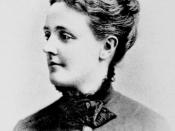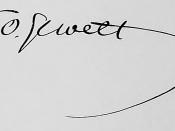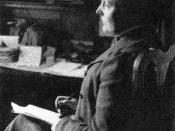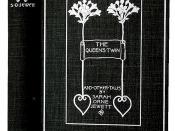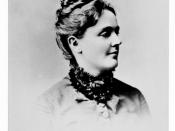Sarah Orne Jewett uses a third person omniscient narrator in an excerpt from "A White Heron"� to portray Sylvia, a courageous girl, giving her utmost bravery and might to conquer an enormous tree to see the sun from the top. The story is given a tone of fascinated satisfaction through the use of such diction as "harmless housebreaker,"� "voyaging earth,"� and "awesome world"� which emphasizes the feeling of accomplishment she had overcoming each of the obstacles.
In the exposition, Sylvia is portrayed to have nothing but her bare feet and hands to tackle the tree, but she is willing to face her challenge. The description of the setting is given life by the use of personification such as "huge tree asleep,"� giving the tree the human quality of sleeping to portray the silence that surrounds the area. Also, nature surrounding her becomes livelier by the use of personification, stressing that this is an adventure rather than a girl climbing a tree.
During the rising action, she ascends the tree, and similes such as the "twig"� being compared to "angry talons"� demonstrates that the tree is not always accepting and it may scar those who pass by. By giving the trees these characteristics, they become alive as a shifting creature who poses a threat, but with every tree that a person passes, they become stronger. Sylvia, in our case, is illustrated as a courageous soul through both direct and indirect characterization as she makes "dangerous pass from one tree to the other."� The story climaxes as Sylvia reaches the apex of the tree and feels the overwhelming splendor of the world around her, striking her with awe and pure amazement. The tree is a symbol of her stages of life and the obstacles that comes with it. Earlier in her life, she does not have to worry about being seriously hurt and is able to poke around and look into things as if she is a "harmless housebreaker."� Then, her life came to a point where she had to make a dangerous leap to the next stage that was capable of nicking her. She cannot stop and continues onward to face her life, feeling as if the obstacle is too much to handle and is unsurpassable, but by the end of the excerpt, she reaches the apex of her current stage. Looking back at the trail she traveled, she feels the success and is further inspired by the world to take the next step, to soar the sky. The contrast of the gray eye of Sylvia to the gray wings of the gliding hawk symbolizes that she must, one day, fly into the sky as well.
This except, on the superficial level, is merely a story of a child climbing a tree, but on the symbolic level, it's a story of a human being's life. The many challenges a person must face to mature in the different stages of life are portrayed as sharp twigs and endless height of the tree, leaving scars on the person as proof that they lived through it. Through Sylvia, the story demonstrates that with stubborn determination, every human being can pass through the obstacles, living life to the fullest and growing from each scar. Then one day, they will soar the sky.

